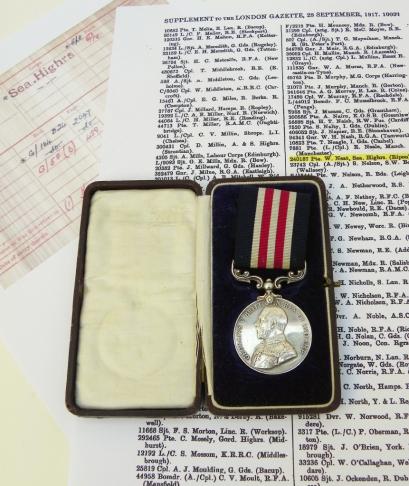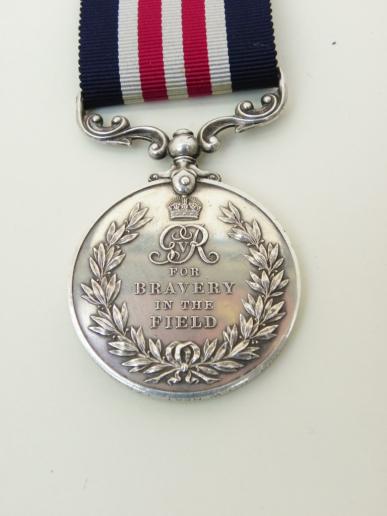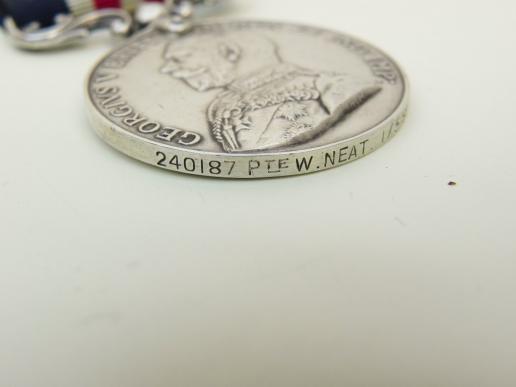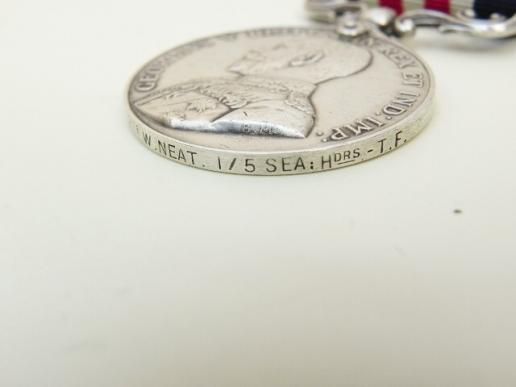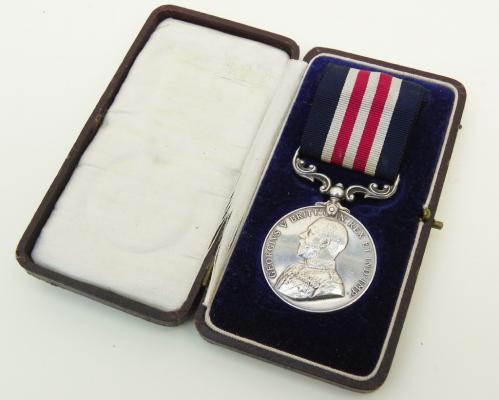WW1 Military Medal to Seaforth Highlanders.
A wonderful gallantry medal correctly named to 240187 Pte. W. Neat. 1/5 Sea:Hdrs.
William E Neat served in France from 1st May 1915; the 5th battalion of the Seaforth Highlanders or the Sutherland and Caithness territorial battalion, they served in France with the 51st Highland division, almost as soon as they landed they were hurried to the defence of Ypres, here the enemy using poison gas for the first time, the allies used every means open to halt the Germans in their surprise attack, the 51st division then moved to an area on the river Lys in an attempt to retake Aubers Ridge in the battle of Festubert around 15th May, still quite green and under-trained, from here on William’s battalion was pretty much constantly on the front line until they moved south just north of the Somme to engage in the attacks on High Wood and the battle of the Ancre in which the Division captured Beaumont Hamel and took more than 2000 prisoners.
It was around April to early August 1917 at the battlefields of Arras that William earned his military medal for gallantry in the field.
It was entered into the London Gazette on 28th September 1917, this along with a copy of his medal index card is included.
*A hard winters frost was still in the ground when the Highlanders found themselves in the line near Arras, again at Roclincourt, braced up by a period of intensive training and unremitting rehearsal for the April 1917 attack on the enemy's lines in the valley of the Scarpe, where every Scottish regiment in the army was represented by the best, and in some cases by most of its battalions.
The Battle of Arras; on a front twelve miles from Lens to Arras, started on 9th April at half-past five in the morning. The 51st Division, which was in the XVII Corps under Sir Charles Fergusson, and part of Allenby's Third Army, was opposite Thélus and facing the outer spurs of Vimy Ridge, in front of which, to the Division's left, lay four Canadian divisions, while on its right was the 34th Division. A fierce enemy barrage preluded the attack; yet Gordon’s, Black Watch, Argyll’s, Seaforth's, and Royal Scots swept through the first objective line of the German trenches as though they had been a triumphal arch. Only at one point called "The Pump" and the trenches east of it was the 152nd Brigade for a little checked by an appallingly concentrated, fire; two hours later they were assailing the second line with the invaluable aid of the tanks.
Rœux and the Chemical Works were not permanently ours till 14th May, when the Fifty-first took them over from the 4th Division and held them through desperate counterattacks. Two days later a new division of the enemy thrust forward north of the Scarpe under an exceedingly heavy barrage, and for a while seriously menaced the Fifty-first in a very awkward situation alongside a railway embankment, flanking it and actually getting to its rear. But this force was virtually destroyed before its daring move had fully developed.
"Convey to 51st Division my congratulations on their great gallantry at Roeux and Chemical Works," wired General Allenby to the Third Army three days later.
At the end of May the Highlanders moved north to the Lys, and took part with the XVIII Corps in the Third Battle of Ypres, which opened on 31st July. For many weeks there had been formidable preparations in the Salient for an attack against the low Flanders ridges, of which the enemy was fully expectant, and for which he was prepared with an amazing concentration of "pill-box" fortresses.
The Fifty-first advanced with a velour there was no withstanding on the dismal morning of the 31st. Every obstacle went down before them; they had learned all that was to be learned about "pill-boxes" and the tactics for them, and these much-vaunted devices of the enemy, with few exceptions, proved comparatively easy to circumvent and put out of action. Mopping up the ground behind them, the Highlanders reached their objective--- the line of Steenbeck---where they dug themselves in and beat off all counter-attacks. So far as the north of the Arras sector was concerned, that opening day of the Arras battle was a decided victory for Britain.
A miserable month, for weather, followed; all active operations were impossible, and only once again on this front---on 20th September, on the Poelcapelle road---did the Fifty-first get into grips with the Germans. These were Prussian troops whom they handsomely thrashed.
Before the Highlanders quitted the XVIII Corps at the end of September, the Corps Commander wrote to say how much he had appreciated their services throughout three months of strenuous fighting. "What has struck me most," he said, "is the thoroughness of the organization within the Division, and the fact that all usual war problems have been thought out beforehand, discussed in detail, and are embodied in simple doctrines well known to all ranks. The result is the Division always fights with gallantry, and can be depended on to carry out any reasonable task which may be allotted to it in any battle. For this reason I venture to place it among the three best fighting divisions I have met in France during the past three years." *
A lot more research is needed to find Williams citation, I have written to the Highlanders museum to see if they could locate Williams’s citation, but I have had no reply, not even an acknowledgement of my letter, I won’t get on my soap box here, but you would think they would care about one of the highlander’s bravest sons. Anyway, if I hear anything I will add it or pass it on.
The medal itself is in excellent condition and on its original ribbon; it comes not in its original case but a beautiful fitted medal case of the same period.
A scarcer MM to a man of small territorial battalion which was grossly under-trained when arriving in France and one that earned the respect and admiration of every division on the western front.
*Excerpts from the 51st Division War Sketches by Fred A Farrell. Text by Neil Munro.
Code: 16011

